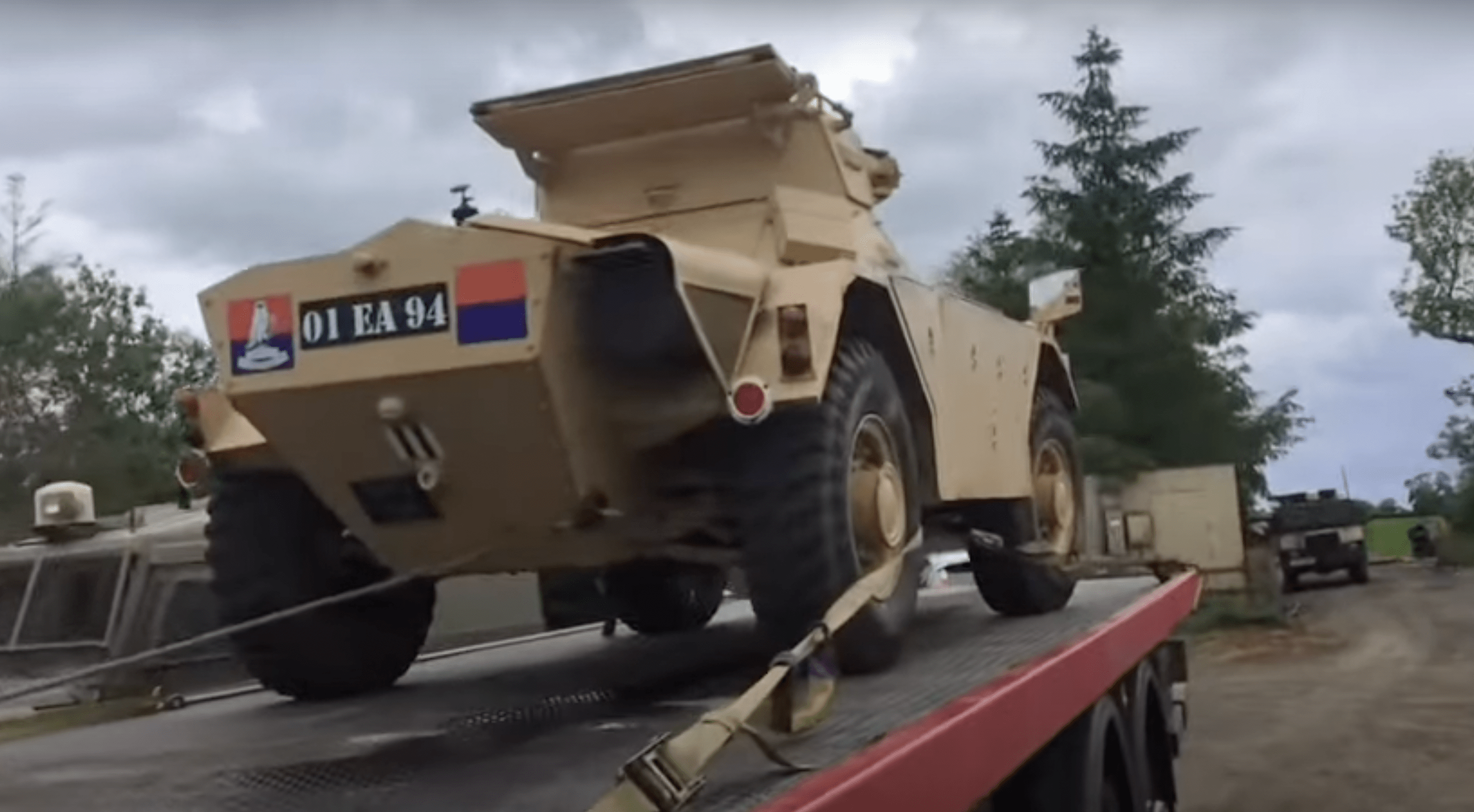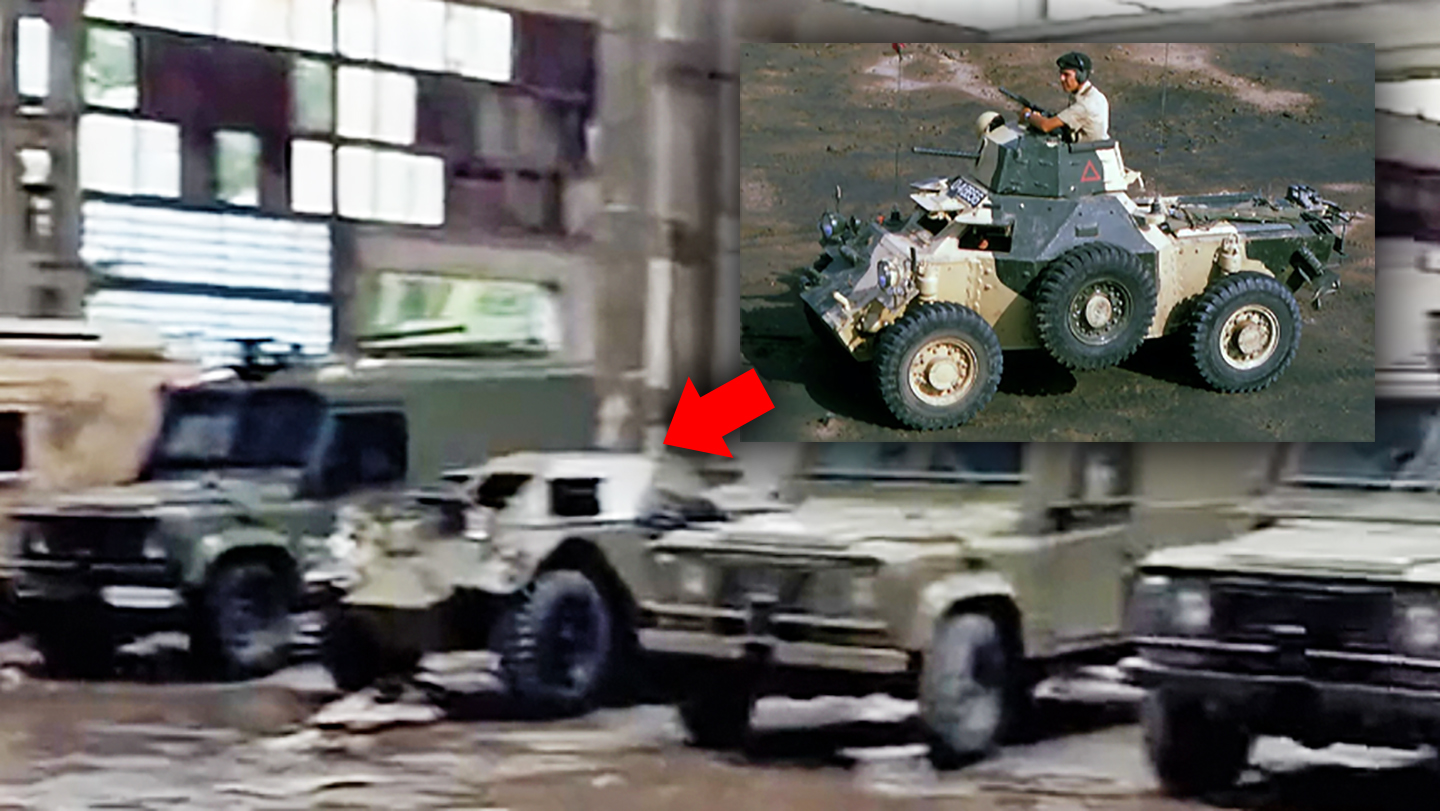Among the increasingly varied assortment of heavy weaponry and other materiel being supplied to Ukraine to support its resistance to the Russian invasion, one Cold War-era veteran really stands out. At least one example of the British-made Daimler Ferret scout car is now in Ukraine, apparently having been provided by a privately funded initiative, and more are either already there or on their way.
A brief video showing posted by the always excellent @UAWeapons shows a Ferret purportedly within a Ukrainian warehouse. The video began to circulate on social media yesterday.
As well as the single Ferret, there is an assortment of other British-origin vehicles, including around a dozen Snatch Land Rovers, a ‘protected’ up-armored patrol vehicle developed in the 1990s based on the famous Land Rover Defender 110 chassis. Also visible are apparently three Vector 6×6 up-armored patrol vehicles, which are based on the Pinzgauer 718 chassis. Like the Snatch Land Rover, the Vector was developed for the British Army. Both of these vehicles faced their fair share of criticism once in service, primarily in regard to their limited armor protection, and are now fairly widely available for sale as military surplus.
The Ferret, however, is a significantly older design, its appearance sharing more in common with World War II-era armored cars than modern fighting vehicles.

Indeed, the development of the Ferret was spurred, in part, by the success of the Daimler Dingo scout car in World War II, and a requirement for what became the Ferret was issued as early as 1946, by what was then still known as the War Office.

At one time apparently known as the Field Mouse, the new armored car had received a somewhat more ferocious name by the time the Ferret entered service with the British Army in 1952.
Typical of armored cars of its era, the Ferret has accommodation for the driver at the front, the commander/gunner in the center, and the engine and transmission at the rear. Powered by a six-cylinder Rolls-Royce petrol engine, it has a maximum road speed of 58 mph and a range of up to 190 miles.
The Ferret was a huge success, with more than 4,400 eventually being built by the time production came to a close in 1971. Ferrets saw combat in dozens of different conflicts and insurgencies. In British hands, these included the campaign in Aden, peacekeeping in Cyprus, the Malayan Emergency, Northern Ireland, and the Suez Crisis.

The Ferret was still in British Army service into the early 1990s, while around 30 export operators also used the vehicle, which served in every continent outside of the Americas.
The major production versions included the Ferret Mk 1 which featured an open-topped hull from which a pintle-mounted 30-caliber Browning or Bren machine gun could be fired. The Ferret Mk 1/2 had a three-man crew, a low-profile turret, and an externally mounted machine gun.

The next major version was the Ferret Mk 2/3, with a one-man turret with a 30-caliber machine gun, similar to that fitted to the Alvis Saracen armored personnel carrier.
Efforts to up-arm the vehicle produced the Ferret Mk 2/6, which added a Vickers (later British Aerospace Corporation) Vigilant wire-guided anti-tank guided missile, or ATGM, on either side of the same turret as used in the Ferret Mk 2/3. The Ferret Mk 5, meanwhile, introduced a more capable second-generation ATGM, the British Aerospace Dynamics Swingfire, carried in two-round launcher ‘bins’ on either side of the turret.

Modifications to in-service vehicles then produced the Ferrets Mk 3 and 4, which were basically earlier variants re-fitted with more robust suspensions and larger tires, as well as flotation screens for amphibious operations.
There has been some discussion as to which variant is seen in the Ukrainian video, although the apparent lack of turret suggests a Ferret Mk 1, or at least a later model from which the turret has been removed.
Intriguingly, a video published by the Tanks-A lot channel on YouTube in May, under the title “Preparing and buying for Ukraine,” provides a close look at one particular Ferret being prepared for transfer to Ukraine, although the destination is not mentioned by name. “We all know where it’s going,” the narrator says, “and it will do someone a lot of good.”

Described as being “like new,” that particular Ferret is claimed to have only around 300 miles on the clock and another example is seen inside a workshop at the same site. It’s also explained that smoke dischargers, radios, and other ancillary equipment are all being removed before delivery, to ensure the vehicles are all to the same standard.
In all, the video states that a total of 12 vehicles of undisclosed types had been made ready for transfer to Ukraine, including several Snatch Land Rovers, one of which, in desert camouflage, is also seen being stripped down.
At the very end of the video is a front view of a Pinzgauer with a Ukrainian flag on the fender and the same vehicle is seen in more detail in the following video. The narrator explains that a “gentleman has come over from Ukraine and he’s bought this one and a few more.” This would tie in with unconfirmed reports that a member of the Ukrainian Armed Forces had purchased a Pinzgauer from a private company, before donating it to the military.

Ultimately, it seems likely that at least some of the vehicles seen in the Ukrainian warehouse could well originate from this collection.
The vehicles in question were all being offered for sale by Tanks-A Lot, a company that provides tank driving experiences for paying customers as well as selling surplus military vehicles, including light tanks and self-propelled guns.
The company website already shows a single Ferret as having been sold, as well as assorted Snatch Land Rovers and a Vector Pinzgauer. Also marked as sold is a Stormer “with Starstreak,” another type that’s known to have been supplied to Ukraine in recent months.
The video also shows a desert-painted Ferret loaded on a truck ready for transfer to Ukraine. It’s explained that this example belonged to a private collector, but it’s been donated to support the Ukrainian war effort.

The British government has apparently made use of open-market stocks of surplus M109 155mm self-propelled guns for delivery to Ukraine. The government announced in July that it would provide Kyiv with more than 20 M109s, which multiple sources reported would be former Belgian Army examples sourced from private suppliers, rather than from the British Army. It’s conceivable the British Army might have been buying back Snatch Land Rovers and Pinzgauers, too.
While the Snatch Land Rover and Vector Pinzgauer are fairly modern vehicles that should be useful for utility and light transport tasks, at least in less-contested areas, it’s by no means clear exactly how the Ferret will be used by the Ukrainian Armed Forces.
When introduced, the Ferret was intended for reconnaissance duties, including scouting ahead of armored formations, where it would venture very much into harm’s way. Even on the modern battlefield, however, with its manifold hazards, from minefields to attack helicopters and ATGMs, a scout car like this could have its uses, especially for reconnaissance or hit-and-run attacks, while providing its crew with some degree of cover, especially from nearby artillery.
The Ferret’s hull is of all-welded steel construction up to a thickness of around 0.5 inches, offering protection only against small arms fire and shell splinters. Although four-wheel drive, the Ferret also doesn’t have power-assisted steering, making maneuvering the vehicle fairly demanding in some instances.

Perhaps the vehicle would be better suited to internal security-type missions, another role in which it has been used historically. Certain territorial units could well be interested in any added even slightly protected mobility. Furthermore, the simple and rugged Ferret should be easy to maintain; one Tanks-A Lot video suggests that they are easier to fix, and to source spares for, than the Snatch Land Rover or Pinzgauer.
One of the Tanks-A Lot videos notes that the Ferrets are having their machine gun mountings removed prior to delivery, with the expectation that, once in Ukraine, they will be “firing missiles out of them.” That may seem surprising, but, so far, the Ukrainian Armed Forces have shown remarkable ingenuity when it comes to employing weapons and equipment from a variety of sources. Adding a small external ATGM is certainly a possibility. Potentially, the Ferrets could also be used to carry a single Javelin missile operator, for example, who would dismount and fire, using ‘shoot and scoot’ tactics. After all, we have seen Ukrainian troops use far-less protected platforms in that role, as well as in other direct-action capacities.
Nevertheless, a late 1940s-era armored car being used to move missile teams around Russian lines might even stretch Ukrainian levels of resourcefulness.
However, with vehicles and weapons transferred to Ukraine frequently being exposed to coverage via official and unofficial channels, including in action, we might not have to wait long until we see how the Ukrainian Ferrets will be employed.
Contact the author: thomas@thedrive.com
